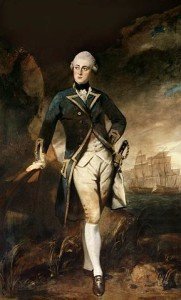The Capture of the Protee – 24 February 1780
Following a comprehensive victory in the Moonlight Battle of 18 January and its subsequent relief of Gibraltar, the British fleet re-entered the Atlantic Ocean and on 18 February parted company with the commander-in-chief, Admiral Sir George Rodney and his West Indies-bound four sail of the line. Under the command of Rear-Admiral Hon. Robert Digby the remaining fifteen sail of the line and the emptied supply ships headed north for England. Amongst this force was the Shrewsbury 74, Captain Mark Robinson, which had missed the battle after escorting the damaged Dublin 74 into Lisbon, the Monarch 74, Captain Adam Duncan, whose crew had refused to sail to the West Indies with Rodney, and the surviving Spanish prizes, Fenix 90, Princesa 74, Diligente 74, and Monarca 74.
On 23 February, to the south of Madeira, Digby had the good fortune to fall in with a French convoy under the command of Captain Vicomt Charles Louis du Chilleau de La Roche, and consisting of the richly laden Prot e 64, Captain Jean Baptiste Valmenier de Cacqueray, the Ajax 64, frigate Charmante 32, corvette Argus, and fifteen supply ships, all of which were bound from Lorient for Mauritius.
With du Chilleau sending the Ajax and the majority of the convoy away, but keeping the Charmate and the smaller supply ships close with him, the Prot e then bravely attempted to protect her consorts as the light began to fade. By one o clock the next morning, being satisfied that he had fulfilled his duty with regards to the safety of the greater number of his charges, du Chilleau then attempted to make good his own escape with the Prot e, but in attempting to sail closer to the wind she lost her main-topgallant-mast and sustained further damage to her fore-rigging and foresail.
This unfortunate occurrence allowed Commodore Sir Chaloner Ogle s Resolution 74, commanded by the newly posted Captain Lord Robert Manners, to catch up with the Frenchman at 2 a.m. and open fire, being joined in her attack by the Bedford 74, Captain Edmund Affleck and the Marlborough 74, Captain Taylor Penny. The Prot e was clearly unable to save herself, but she fought on regardless until she had lost the use of her wheel and was wallowing helplessly before her enemies. At 3.15 Captain de Cacqueray struck his colours, having suffered casualties of thirty-two men killed and countless wounded. In addition to the Prot e three supply ships were also captured, but the Charmante escaped and made her way back to Lorient on 3 March. The French captains would later be honourably acquitted by a court of Inquiry that fully approved of their conduct.
In taking possession of the Prot e, Ogle s men had to unburden some of the French seamen from the loot which they had taken the opportunity in the confusion to steal from her. The Bienfaisant and Royal George escorted her into Plymouth, whilst Digby reached Spithead with the rest of his command on 26 March. The prizes earned the captors 64,000, being mostly the value of silver and coin found aboard the Prot e.
The Prot e, which had been launched at Brest in 1772, was bought into the navy as the Prothee 64 and commissioned not long afterwards by Captain Charles Buckner. She saw active service throughout the remainder of the American Revolutionary War, including at the Battle of the Saintes under Buckner in 1782. In 1795 she was fitted out as a prison ship, and she was finally broken up at the end of the Napoleonic War in 1815.

